Kepler-186 is a red dwarf star located 579 light years away in the northern constellation Cygnus (the Swan). With an apparent magnitude of 15.29, it is invisible to the unaided eye. It hosts a system of five orbiting planets. The outermost planet, Kepler-186f, was the first Earth-sized planet discovered orbiting in the star’s habitable zone.
Star type
Kepler-186 is a red main sequence star of the spectral type M1V. The star is much cooler, smaller and less luminous than the Sun. It has a mass of 0.544 solar masses and a radius of 0.523 solar radii. With an effective temperature of 3,755 K, it shines with only 0.055 solar luminosities. The star has an estimated age of around 4 billion years. It takes 34.404 days to complete a rotation.
Kepler-186 is classified as a BY Draconis variable. Its brightness has been observed to vary slightly with a period of 33.695 days. BY Draconis variables are K- or M-type main sequence stars that exhibit variations in brightness because of starspots or other chromospheric activity coupled with the effect of rotation.
Many nearby red dwarfs belong to this class, including Barnard’s Star, Epsilon Eridani, Luyten 726-8, Lalande 21185, Lacaille 8760, Kapteyn’s Star, Ross 248, and 61 Cygni (Bessel’s Star).

A 2MASS J band image, the star 2MASS J19543665+4357180 (Kepler-186) is highlighted. Atlas Image mosaic obtained as part of the Two Micron All Sky Survey (2MASS), a joint project of the University of Massachusetts and the Infrared Processing and Analysis Center/California Institute of Technology, funded by the National Aeronautics and Space Administration and the National Science Foundation. (PD)
Planets
Kepler-186 hosts a planetary system of five orbiting planets. The planets are designated Kepler-186b, Kepler-186c, Kepler-186d, Kepler-186e, and Kepler-186f. Only the outermost of the five planets, Kepler-186f, orbits in the host star’s habitable zone. The other four planets orbit closer to the star. They are believed to be tidally locked (always facing the star with the same side) to Kepler-186.
The five planets in the Kepler-186 system were confirmed and announced in 2014. All five are larger and more massive than Earth and believed to have a solid surface. They orbit Kepler-186 with periods of 3.89 to 129.9 days at distances of 0.0343 – 0.432 astronomical units (Earth – Sun distances).
Kepler-186b has an estimated mass of around 1.24 Earth masses and a radius of 1.07 Earth radii. It orbits Kepler-186 with a period of only 3.8867907 days at a distance of 0.0343 AU.
The larger Kepler-186c has a radius 1.25 times that of the Earth and a mass of 2.1 Earth masses. It has an orbital period of 7.267302 days and a semimajor axis of 0.0451 AU.
Kepler-186d has about 2.54 times the Earth’s mass and a radius 1.4 times that of our planet. It orbits Kepler-186 at a distance of 0.0781 AU with a period of 13.342996 days.
Kepler-186e has a mass of 2.15 Earth masses and a radius of 1.27 Earth radii. It has an orbital period of 22.407704 days and lies at an orbital distance of 0.11 AU from the host star.
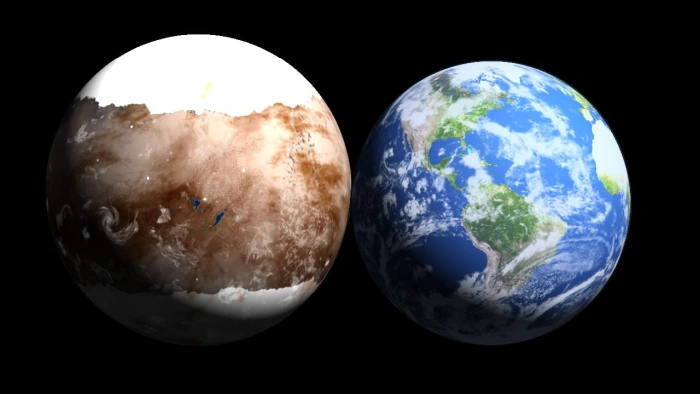
Kepler-186f compared to Earth, image credit: Wikimedia Commons/Canis987*& (CC BY 4.0)
Kepler-186f, the outermost confirmed planet, has a mass of around 1.44 Earth masses and a radius 1.17 times that of the Earth. It orbits the star at a distance of 0.432 AU with a period of 129.9444 days.
Modelling has shown that there may be a sixth non-transiting planet orbiting Kepler-186 between Kepler-186e and Kepler-186f. If it exists, the planet is probably not significantly more massive than Earth. Astronomers have hypothesized that there could be two smaller planets between Kepler-186e and Kepler-186f, and possibly a larger planet orbiting the star beyond Kepler-186f.
The Kepler-186 planetary system was discovered by NASA’s Kepler space telescope using the transit method. It was confirmed by observations with the W. M. Keck Observatory and the Gemini Observatory (Gemini North telescope) on Mauna Kea, Hawaii.
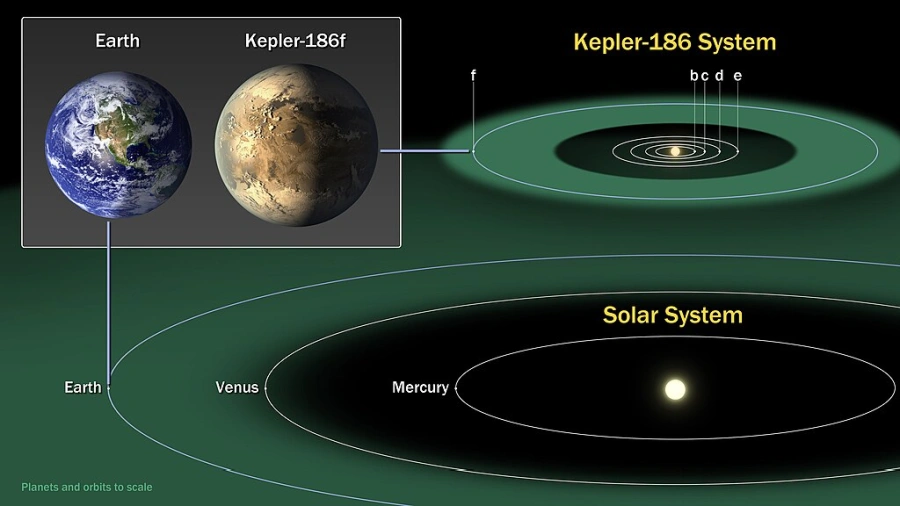
Kepler-186 and the Solar System: The diagram compares the planets of the inner solar system to Kepler-186, a five-planet system about 500 light-years from Earth in the constellation Cygnus. The five planets of Kepler-186 orbit a star classified as a M1 dwarf, measuring half the size and mass of the sun. The Kepler-186 system is home to Kepler-186f, the first validated Earth-size planet orbiting a distant star in the habitable zone—a range of distances from a star where liquid water might pool on the surface of an orbiting planet. The discovery of Kepler-186f confirms that Earth-size planets exist in the habitable zone of other stars and signals a significant step closer to finding a world similar to Earth. Kepler-186f is less than ten percent larger than Earth in size, but its mass and composition are not known. Kepler-186f orbits its star once every 130-days and receives one-third the heat energy that Earth does from the sun, placing it near the outer edge of the habitable zone. The inner four companion planets all measure less than fifty percent the size of Earth. Kepler-186b, Kepler-186c, Kepler-186d, and Kepler-186e, orbit every three, seven, 13, and 22 days, respectively, making them very hot and inhospitable for life as we know it. The Kepler space telescope, which simultaneously and continuously measured the brightness of more than 150,000 stars, is NASA’s first mission capable of detecting Earth-size planets around stars like our Sun. Kepler does not directly image the planets it detects. The space telescope infers their existence by the amount of starlight blocked when the orbiting planet passes in front of a distant star from the vantage point of the observer. The artistic concept of Kepler-186f is the result of scientists and artists collaborating to help imagine the appearance of these distant worlds. Image credit: NASA Ames/SETI Institute/JPL-CalTech (CC BY 4.0)
Kepler-186f
Kepler-186f is an Earth-sized planet that orbits within the habitable zone of Kepler-186. It orbits the star at a distance of around 0.43 AU (64 million km or 40 million miles), taking around 130 days to complete an orbit. It was the first validated Earth-size planet discovered in the host star’s habitable zone, which extends from 0.22 to 0.40 AU from the star. As such, Kepler-186f is among the more promising potentially habitable exoworlds.
The habitability of Kepler-186f has not yet been determined. It is unclear whether the planet has an atmosphere, what its composition is, and whether conditions on the planet’s surface allow for liquid water to exist there.
The discovery of Kepler-186f was announced on April 17, 2014. A paper presenting the discovery of a planet with a radius comparable to that of the Earth orbiting in the parent’s star habitable zone was published in the journal Science. A team of scientists, led by Elisa Quintana of the SETI Institute, determined the planet’s orbital elements and refined its mass and radius estimates. Based on observations with the Keck II and Gemini North telescopes, the astronomers confirmed the planet’s existence.
The team constrained the composition of all five Kepler-186 planets using thermal evolution models. They concluded that any hydrogen/helium envelope on Kepler-186f would have likely been stripped by the intense ultraviolet flux from the host star when the star was younger.
Kepler-186 does not have a molecular hydrogen-rich atmosphere. However, it is possible that it could hold on to water, as well as iron and silicate rock.
The planet receives around 32% of the insolation that the Earth receives from the Sun and stays within the goldilocks zone throughout its orbit. It orbits in the outer portion of the habitable zone.
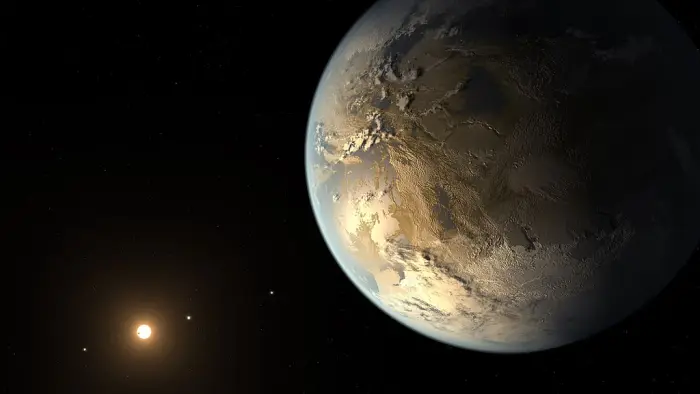
The artistic concept of Kepler-186f is the result of scientists and artists collaborating to help imagine the appearance of these distant worlds. Credit: NASA Ames/SETI Institute/JPL-CalTech (CC BY 4.0)
Name
Kepler-186 does not have a proper name formally approved by the International Astronomical Union (IAU). The catalogue designation Kepler-186 comes from NASA’s Kepler mission. Named after the German astronomer and mathematician Johannes Kepler, the Kepler space telescope was launched in 2009 and assigned to search a portion of the sky for Earth-like extrasolar planets. The telescope observed more than 500,000 stars and detected 2,778 confirmed exoplanets and over 5,000 candidate planets by the time it was retired in 2018.
Kepler-186 was listed as KIC 8120608 in the Kepler Input Catalog and, once the planets were detected orbiting the star, it was catalogued as KOI 571 (Kepler Object of Interest).

The artist’s concept depicts Kepler-186f, the first validated Earth-size planet orbiting a distant star in the habitable zone—a range of distances from a star where liquid water might pool on the surface of an orbiting planet. The discovery of Kepler-186f confirms that Earth-size planets exist in the habitable zone of other stars and signals a significant step closer to finding a world similar to Earth. The artistic concept of Kepler-186f is the result of scientists and artists collaborating to help imagine the appearance of these distant worlds. Image credit: Danielle Futselaar (CC BY 4.0)
Location
Kepler-186 appears in the wing of the Swan (Cygnus), along the line extended from Fawaris (Delta Cygni) to Sadr (Gamma Cygni). Sadr and Fawaris form a prominent asterism known as the Northern Cross with Deneb (Alpha Cygni), Aljanah (Epsilon Cygni) and Albireo (Beta Cygni). These are the brightest stars in Cygnus. The bright Deneb forms the Summer Triangle with Vega in the constellation Lyra and Altair in Aquila.
At declination +43° 57′, Kepler-186 never rises above the horizon for observers south of the latitude 46° S.
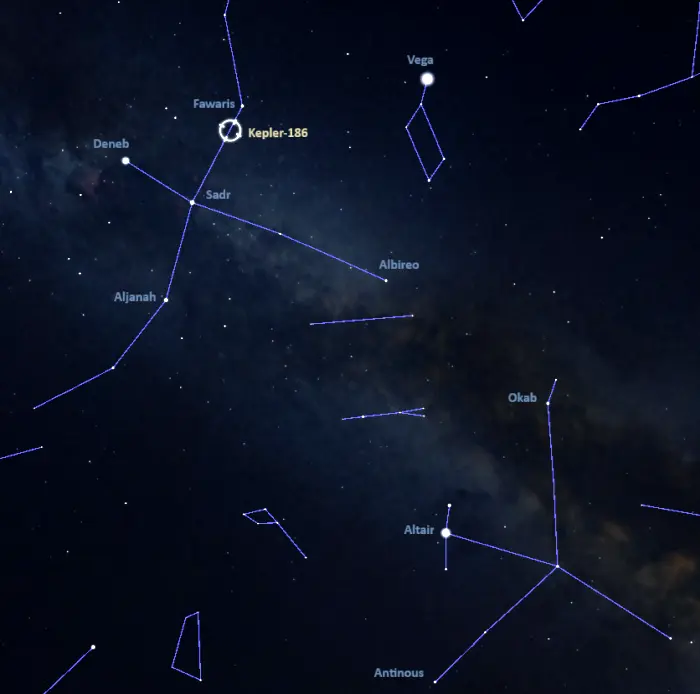
Kepler-186 location, image: Stellarium
Constellation
Kepler-186 is located in the constellation Cygnus. The celestial Swan is one of the 48 Greek constellations, catalogued by the astronomer Claudius Ptolemy of Alexandria in his Almagest in the 2nd century CE. In Greek mythology, the constellation is associated with the story of Zeus transforming himself into a swan to seduce the Spartan queen Leda. Cygnus is sometimes also linked with Cygnus, a friend of Phaethon (the son of Helios, the Sun god), as well as with the Greek poet and musician Orpheus, placed into the sky next to his lyre, represented by the constellation Lyra.
Cygnus is the 16th largest constellation in the sky. It occupies 804 square degrees of the northern sky between the constellations Cepheus, Draco, Lyra, Pegasus, Vulpecula, and Lacerta.
The five brightest stars in Cygnus – Deneb, Sadr, Aljanah, Fawaris and Albireo – form the Northern Cross, one of the most familiar asterisms in the northern hemisphere.
Deneb, the constellation’s brightest star, is a blue-white supergiant star that shines at magnitude 1.25 from a distance of 2,615 light-years. Sadr (Gamma Cygni) is a yellow-white supergiant located approximately 1,800 light-years away, and Aljanah (Epsilon Cygni) is a cooler orange giant 72.7 light-years away. Fawaris (Delta Cygni) is an A-type subgiant, and the primary component in the Albireo (Beta Cygni) system is an orange bright giant star.
Other notable stars in Cygnus include the red hypergiant NML Cygni, one of the largest stars known, Bessel’s Star (61 Cygni), a binary system composed of two orange dwarfs only 11.404 light-years away, and Tabby’s Star (KIC 8462852), a star known for its unusual changes in brightness.
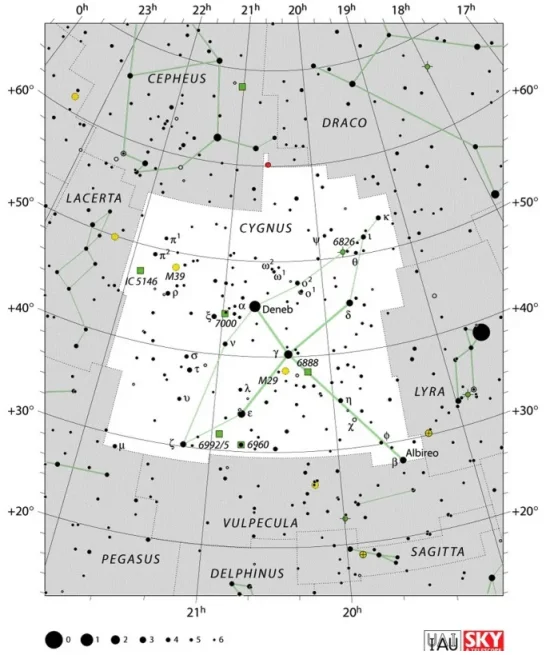
Cygnus constellation map by IAU and Sky&Telescope magazine (Roger Sinnott & Rick Fienberg) (CC BY 3.0)
The constellation also hosts the Sun-like stars Kepler-22 with an orbiting exoplanet (Kepler-22b) and Kepler-11 with six orbiting planets, and the yellow subgiants Kepler-452 with a rocky super-Earth orbiting in the star’s habitable zone and Gliese 777 with three planets.
Deep sky objects in Cygnus include the Fireworks Galaxy (NGC 6946), the open clusters Messier 29, Messier 39 and the Rocking Horse Cluster (NGC 6910), the North America Nebula (NGC 7000), the Pelican Nebula (IC 5070), the Gamma Cygni Nebula (IC 1318), the Crescent Nebula (NGC 6888), the Veil Nebula (Caldwell 33 and 34), the Blinking Planetary Nebula (NGC 6826), the Methuselah Nebula (MWP 1), the Fetus Nebula (NGC 7008), the Soccer Ball Nebula (Kronberger 61), the Cheeseburger Nebula (NGC 7026), and the Footprint Nebula (M1-92).
The best time of the year to observe the stars and deep sky objects in Cygnus is during the month of September, when the constellation appears high above the horizon in the early evening. The entire constellation can be seen from locations north of the latitude 40° S.
The 10 brightest stars in Cygnus are Deneb (Alpha Cyg, mag. 1.25), Sadr (Gamma Cyg, mag. 2.23), Aljanah (Epsilon Cyg, mag. 2.48), Fawaris (Delta Cyg, mag. 2.87), Albireo (Beta Cyg, mag. 2.90), Zeta Cygni (mag. 3.21), Xi Cygni (mag. 3.73), Tau Cygni (mag. 3.65 – 3.75), Iota2 Cygni (mag. 3.77), and Kappa Cygni (mag. 3.814).
Kepler-186
| Spectral class | M1V |
| Variable type | BY Draconis variable |
| Apparent magnitude | 15.29 |
| Apparent magnitude (J) | 12.473 |
| Apparent magnitude (H) | 11.605 |
| Apparent magnitude (K) | 11.605 |
| Distance | 579 ± 2 light-years (177.5 ± 0.5 parsecs) |
| Parallax | 5.6336 ± 0.0169 mas |
| Radial velocity | -62.023998 ± 0.026838 km/s |
| Proper motion | RA: 2.171 ± 0.018 mas/yr |
| Dec.: -4.363 ± 0.020 mas/yr | |
| Mass | 0.544 ± 0.02 M☉ |
| Luminosity | 0.0055 L☉ (0.049 – 0.066 L☉) |
| Radius | 0.523 ± 0.02 R☉ |
| Temperature | 3,755 ± 90 K |
| Metallicity | −0.26 ± 0.12 dex |
| Age | 4.0 ± 0.6 billion years |
| Rotation period | 34.404 ± 0.075 days |
| Constellation | Cygnus |
| Right ascension | 19h 54m 36.6535147493s |
| Declination | +43° 57′ 18.025920330″ |
| Names and designations | Kepler-186, KIC 8120608, KOI-571, AP J19543665+4357180, TIC 268159861, UCAC4 670-080738, 2MASS J19543665+4357180, Gaia DR2 2079000330051813504, Gaia DR3 2079000330051813504 |